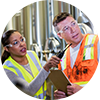Shifting Focus from Pain to Function
View Concentra’s Webinar on Shifting Focus from Pain to Function
In this webinar, you will learn about:
- Recent neuroscience research that gives new insights into pain
- The injured employee’s perception of pain and the impact on medical outcomes
- An alternative to the traditional analog pain scale
PRESENTER BIO
Maja Jurisic, MD, vice president, medical director of strategic accounts, who is introduced by Anna Kleiner, Content Marketing Manager. Dr. Jurisic has been with Concentra for nearly thirty years and is board certified in emergency medicine and occupational medicine. As an industry expert in return to work and occupational health, she acts as a consultant serving eight states under a federal initiative to improve return to work/stay at work outcomes for injured employees.
0:00
Anna Kleiner, content marketing manager
Hello, everyone. Welcome to the Concentra webinar, what employers need to know about “Shifting Focus from Pain to Function.” Today’s webinar will be presented by Dr. Maja Jurisic. Dr. Jurisic has been in practice with Concentra for nearly 30 years of her 40 years as a physician. She is board certified in emergency medicine and occupational medicine and is a leading advocate of a pain scale alternative that is helping to lessen national opioid use.
0:32
Dr. Jurisic is also a consultant to the US Department of Labor, serving eight states under a federal initiative to improve return-to-work and stay-at-work outcomes for injured employees. At the conclusion of the presentation, we will have a 10-to-15-minute Q&A session with Dr. Jurisic. You can submit your questions throughout the presentation, to be answered during the Q&A session with Dr. Jurisic. We will answer as many questions as possible within the time allowed. A recording of the webinar will be emailed to you after the presentation, so you can view it again at your convenience. Dr. Jurisic, we’re ready to begin.
1:05
Dr. Maja Jurisic
Thank you, Anna, and thank you all for joining us this afternoon to learn more about a topic that I think is really important to all of us – not just in our work lives, but also in our personal lives. An alternate title to this presentation could have been, “Ending the Reign of Pain,” which I think actually started in this country around the turn of the century.
1:30
Toward the late 1990s, actually, the American Pain Society, which was, by the way, largely funded by Purdue Pharma, offered up the idea that we were under-treating pain in the United States. They advocated including pain as the fifth vital sign that should be measured at every patient visit. The Joint Commission on Accreditation of Healthcare Organizations jumped on the pain bandwagon and launched a campaign in 2001 to treat pain more vigorously.
Growth of the Pain Scale
2:03
As they traveled the country, inspected health care facilities and decided whether to accredit them, one of the things they checked was whether that institution was using the Visual Analog Pain Scale. That’s the chart with the happy and sad faces corresponding to how much pain someone is feeling. Since the hospital systems couldn’t take care of Medicare patients unless they were accredited, everyone made the use of the pain scale mandatory.
2:33
Pretty soon it was so ingrained into the system that when I recently took my 93-year-old mother to an outpatient visit, we couldn’t even register her until she told them what her pain was on the visual analog pain scale. And, you know, hearing all this, hearing that they had a right to adequate pain control, some patients interpreted this as a right to be pain free. And physicians felt pressured to rid their patients of pain and were, in fact, reprimanded, if it was thought that they were under-treating pain.
Why Concentra Threw Out the Pain Scale
3:10
So, I am going to spend the rest of our time together sharing why Concentra decided to throw out the pain scale – not the least of the reasons was that, after the pain scale became ubiquitous, there was an alarming rise in the prescription of pain medication, as well as overdoses and deaths of patients due to prescription opioids. I don’t think that was a coincidence. I do think they were related.
3:35
So, as you can tell, I don’t think that the Visual Analog Pain Scale has been serving us well. In the 40 years since I graduated from medical school, we’ve actually learned some very interesting things from research in the neurosciences. In medical school, we learned that, you know, our brains mature until adulthood, and then it’s pretty much a matter of losing neurons until you die. That’s kind of a bleak picture, but now we know it’s not true.
Neuroplasticity: A Fantastic Superpower
4:04
We’ve learned that our brains have neural plasticity, which means they can reorganize themselves and continue to form new connections throughout our entire lives. By choosing which neural pathways to activate, we can actually change our brain anatomy. So, the more we activate particular pathways, the deeper they grow and the faster they become at sending messages. Neuro scientists have taught us that where attention goes, neural firing flows, and neural connection grows. When you think about that, it’s really a pretty fantastic superpower, if we choose to use it. Unfortunately, pain is the dark side of neuroplasticity because our brains are not passive computers that just receive and register pain signals. But, because they are actively involved in either shrinking or growing pain, studies have shown that focusing on pain actually lights up pain regions in the brain. A patient can literally grow pain by thinking about it and how terrible it is. So how and how often patients think about pain can actually make their perception of pain better or worse.
5:15
At Concentra, we’ve learned both from looking at the literature and from our own patient data that focusing on function is more effective in helping people renormalize their lives after they’ve been disrupted by work injury than harping on pain. And this is particularly important in cases where a patient’s subjective complaints exceed the objective findings because we know that pain is not invariably a signal of ongoing tissue injury. Next slide.
Definition of Pain: Two Takeaways
5:48
The most widely accepted definition of pain comes from the International Association for the Study of Pain, and it states: “Pain is an unpleasant sensory and emotional experience associated with actual or potential tissue damage or described in terms of such damage.” So, two important takeaways from this are that pain is an experience with an emotional component and it may or may not be associated with tissue damage.
6:18
How people think and feel about their situation can determine whether their pain gets better or worse. If they’re afraid or angry or stressed, they feel more pain than if they’re calm. If they feel heard, if they feel their employer or their doctor really cares about them, they feel less pain. Pain pathways can become persistent if they keep being activates, such as when we repeatedly ask patients to rate their pain. That’s why people continue to feel pain, even though their tissues are healing. It’s also possible for the perception of pain to come and go, depending on whether the danger signal in the brain is activated. Next slide.
Where Pain Comes From
7:02
The title of this next slide is, “The Reign of Pain Lies Mainly in the Brain.” That’s a statement of fact. The way we’re wired is that all of our body parts have sensors that trigger constant messages to the brain about our current state. These messages are electrical impulses. We have millions of sensors scattered throughout our joints or muscles or ligaments. But, and this is a big but, these messages, these electrical signals are not pain. They are danger messages. Pain is something totally different. Pain is made by the brain 100 percent of the time.
7:41
Our brains make pain when they conclude from these messages that we are in danger and we need to do something about it. Pain is one way of making us pay attention, and both physical and emotional injuries activate the same danger signal, which triggers pain to our brain. It’s exactly the same whether it’s an emotional or physical danger. I think much of the confusion comes in when people don’t differentiate between the two because sometimes, frankly, it’s easier to deal with a physical injury than it is to deal with some emotional injury like, you know, a relationship that needs fixing.
Brain Uses Pain to Protect Us
8:19
So, however nasty it is, pain is proof that our nervous system really looks out for us. Your brain, my brain, everyone’s brain is wired to do what is best to keep us safe and to ensure our survival. Nearly anything can provide credible evidence of danger. The diagnosis someone is given, the words a supervisor or an adjustor uses. If the employee perceives them as negative or maybe threatening, seeing findings on an X-ray or scans like degenerative changes – even if the doctors tell the patient those kinds of findings are not clinically significant – degenerative changes sounds pretty scary; and in their attempts to keep us from harm, our brain sometimes gets it wrong.
9:06
One well-known case where this happened was a construction worker who stepped on a nail and it went through the bottom of the shoe and came up on the top, sticking out. He was in a lot of pain. He was thinking about, gosh, this is so complicated. What if I’ve really screwed up. I don’t have any other skills. I really need to be able to stand and walk. So, all these thoughts about, will I be able to return to this job? I make good money. How will I pay my mortgage if I can’t work in construction? All of this was going on in his mind. By the time he got to the hospital, he was in agony.
9:44
So, before they did anything else, they did an X-ray of his foot. The doctor came in smiling and said, hey, you were really lucky. The nail went in the space between your big toe and the next toe. So you didn’t damage any tissues that are important. All of a sudden, his agonizing paid went away just like that. The brain realized, I’m okay. There is no big danger here. So, sometimes, we have to be careful.
10:14
Our pain system can become overly protective. You’ve probably heard the phrase, “Practice makes perfect.” So, when someone has pain for a while, the nerve cells in the spinal cord and the brain actually become more responsive. That person’s pain system becomes more efficient at producing pain. It learns pain. When you learn a new skill, like playing the piano, the nerve cells change their properties to be more responsive. Our bodies have remarkable healing powers. We really are designed to heal after musculoskeletal injuries. So, as time passes, if the post-injury pain remains and patient sensitivity doesn’t go away, it’s unlikely that the injury is getting worse and mysteriously spreading. What’s happening when patients complain of more pain over time, despite appropriate treatment, is that their pain systems are becoming overprotective. So, when an injured worker complains that the pain is moving from one side of his body to the other or from one location to another or new spots are getting sore, or the patient is experiencing frightening muscle spasms, those are usually signs that his body is trying to protect itself, and not a sign of further tissue damage.
Turning Pain Up or Down
11:32
All of these things show that the patient’s system is on alert. This pain can actually be turned up and down by thoughts and feelings going on in that person’s life, things that have nothing to do with the painful body part. So, if a patient comes in and says, I don’t know why, but I’m hurting more this week, instead of rushing to find a new pain generator and ordering an MRI or referring to a specialist, a savvy clinician will take a step back and try to figure out what else might be going on in this person’s life that might be threatening or dangerous to his brain. So, one example I can give you is a patient I saw once when an employer called me and said, I have this guy who’s been just a great employee. He’s always been a hard worker. He hurt his back a while ago, and he’s just not getting better. He’s scared about it, and I’m a little concerned. We don’t know if the doctor who has been seeing him is doing everything he should to investigate.
12:31
So I said, I’d be happy to see him if you’re concerned, and I called the doctor, who is actually one of the most brilliant physicians I’ve ever met. I kind of doubted he was overlooking anything. But, I said, would you mind if I see this patient next time he comes in and he said, no. I showed up for the patient’s next recheck and the first thing I noticed when I walked in the room was that he seemed really scared. He told me he played soccer on a team on the weekends for over a decade. Lots of times, he would get hurt, but he healed really fast. He had always been a good healer. But this time, it had been six weeks since he hurt his back. He just didn’t feel any better, and he was really scared, wondering if there was something terrible going on. His back was just not getting any better.
13:20
I did a very careful examination. There really was no evidence of nerve root impingement or anything more serious going on with the underlying back injury. As we were chatting, it came out that he hurt his back about the same time as his wife had left him. She left him for another man, left him with two kids to take care of on his own. He wasn’t sleeping well. He wasn’t eating. He actually didn’t have an appetite, so he had lost about 20 pounds in six weeks, and he was not a heavy person to start with. We talked about the fact that healing requires that you give your body the building blocks it needs to heal. Some nutrition is important: good protein, minerals, vitamins, etc. We talked about how most of our healing takes place during sleep, so restorative sleep is really important. And we talked a bit about sleep hygiene. He said, so you really think it’s these things that will help me get better and there’s nothing more serious going on?
14:20
And I said, yeah, I think so. He said, well, I guess I feel better about that. There’s something I can do to get better. So, I called the doctor who was treating him the next week to see how he was doing, and he was a whole lot better. The week after that, he was discharged. It’s just because that kind of danger signal turned way down and he was able to start feeling better. Next slide.
Childhood Experiences, Adult Vulnerabilities
14:43
One thing we know absolutely for certain is that an overly protective pain system is not a sign that someone has a weak personality or a weak mind or is exaggerating pain symptoms. It does mean that this person’s neural pathways were altered so that his or her pain system became overprotective. The CDC has been doing studies actually since 1998 on what they call adverse childhood experiences or ACE studies. They’ve shown a stunning link between childhood trauma and things that happen to people in adulthood, both chronic diseases and social and emotional problems. They’ve done more than 60 of these studies, and they showed that childhood trauma is actually very common and not just in deprived areas. It’s experienced by many employed, white, middle-class, college-educated people. There is a direct link between childhood trauma and adult onset of chronic diseases like heart disease and diabetes, as well as depression, suicide, addiction, and alcoholism.
15:55
The more trauma and adverse experiences, the higher the risk of these problems. The studies’ researchers came up with a score to stratify someone’s risk. They gather this score by asking about 10 types of childhood trauma – things like physical, verbal, or sexual abuse, emotional neglect, whether someone had a parent who was an addict or in prison. When a score is four or greater, that’s when things start getting serious. The risks really increase. These higher scores correlate with impaired work performance, with more absenteeism, problems performing the job, and delayed recovery when someone is injured. I don’t think it’s a coincidence that the number of people who have a score of four or more is about the same as the number of patients who have a delayed recovery after a work injury.
16:49
The CDC estimates that 10 to 12-and-a-half percent of the adult population probably have scores that are higher than four. Next slide.
17:02
When I started at Concentra, I was really kind of baffled by cases where I was doing everything I was supposed to do as a physician. I was evaluating the patient, coming up with an accurate diagnosis and an appropriate treatment plan, but the patient was refusing to get better; at least, that’s what it felt like to me. I was following the standard medical approach, so it was tempting to blame the patient. It’s not unusual to hear frustrated clinicians talking about that patient, a very difficult patient when they’re discussing cases where people are not getting better, as anticipated. But what was really going on is that we were using an effective approach and, instead of changing strategies, we continued looking for the pain generator. So when we saw that the standard medical approach lacked efficacy, and it was not helping our patients in the more challenging cases, and that repeatedly asking about pain just made those pathways grow, and patients thought about them, and also quite logically made patients believe that their perception of pain was a reliable way to measure healing because otherwise, why would the doctor keep asking about it? So we knew that there is a human being attached to every injured body part, and that it’s this human being’s unique reaction to his or her work injury, his thoughts, beliefs, emotions, expectations – his view of what’s possible and what the future holds – that these things are all counted in recovery from a work injury.
18:39
The way an injured worker views and interprets his situation, what he things about, what really drives that person’s behavior, which, in turn, has a powerful impact on the outcome. So we decided that instead of prompting the worker to think about pain, we would focus our conversation on function, on what and how much the patient was doing, rather than how much pain he was feeling. We came up with FReSH. Next slide.
A FReSH Approach to Recovery
19:09
FReSH is an alternative to the pain scale. It stands for Functional Restoration/Status of Healing. We still do use the pain scale at the initial injury visit. Acute pain actually correlates pretty well with the severity of the injury. But at recheck visits, we use the FReSH scale. So if somebody is getting physical therapy, our PT colleagues gather and document the objective measures of function. They’re based on the patient’s actual job. So, if someone has to lift a hundred pounds at work, that’s their functional goal. If it’s 50 pounds, that’s their functional goal. We don’t have some universal goal that everyone has to meet to be considered a functional restoration.
19:54
At every recheck, medical clinicians review this and they choose a stage of functional restoration or healing, and it goes all the way from stage one, where somebody has significant difficulties with physical requirements to stage five, where the patient is more than 75 percent of the way to meeting physical requirements. This is really a much more objective and helpful way to measure recovery and to change the conversation. It actually helps clinicians change the conversation because we’ve all begun just asking about the pain scale. It’s become an ingrained habit because that’s what everyone expects you to do. This FReSH approach gives patients a define functional goal that they’re working toward. As treatment progresses, we look at the progression of objective measures to determine how someone is recovering rather than relying on every little nuance of pain.
20:48
Most patients actually don’t start at stage one. Most start at stage, two, three, four, or five and then we encourage patients to keep pushing the envelope and to do a little bit more at every recheck. Ideally, we’d be able to move a patient to a different stage at every recheck, but that doesn’t always happen. But even if it doesn’t, it’s a good time to encourage patients to remain consistent and persistent in their own efforts to further their recovering, centering the conversation around functional restoration and the progression of healing progress as the goal of treatment – and helping patients understand that they are and should be active participants in their own recovery. This is what we believe to be a best practice in the workers’ compensation arena.
How FReSH Differs from the Pain Scale
21:36
So, some of the differences between the pain scale and FReSH. Let’s look at those. The pain scale is a subjective system to measure patient self-reported pain. It’s not a reliable indicator of the healing status. Pain perception is not necessarily associated with tissue damage. Fear, anxiety, and stress all fuel the perception of pain. FReSH is a new way to measure progress. It emphasizes functional restoration. It encourages patients to actively engage in recovery. It helps reduce their need for pain medication and hopefully increases productivity and gets the patient a better outcome, which, in our world, is usually shorter case duration. Next slide.
22:22
So this is a different way of looking this, what we would consider a quality medical outcome, and why we shift from pain to function. It changes the focus from subjective to objective and the patient-physician conversation moves from disability to ability. We highlight the progress made. We celebrate that even if it’s, you know, they can bend further than they could before or they’re now able to walk around the block. Before they could only walk halfway around the block. We try to help them think more about the things they can do rather than the things they can’t do. Next slide.
Benefits of FReSH Focus on Function
23:02
The benefits of this approach. We’re hoping to reduce opioid utilization, increase productivity, and improve outcomes and especially by avoiding creeping catastrophes – you know, those cases that start out with a minor injury but, over time, step-by-step, almost imperceptibly, they end up becoming a work comp disaster with needless disability and needlessly ruin lives, largely because the medical system clung to a failed approach. Next slide.
23:36
We measure everything at Concentra, and we never were a huge user of opioids. But before we started the FReSH approach, we used opioids in 8.2 percent of our cases. You can see that every quarter since this FReSH approach started, opioid use has gone down to the point where we are now at 3.1 percent of cases having opioids prescribed. So that’s a 62 percent reduction, which is pretty good. Next slide.
Final Thoughts: Ending the Reign of Pain
24:13
Final thoughts. This paradigm shift from a focus on pain to focus on function really offers hope that even the most vulnerable injured employees can avoid delayed recovery and they can get back to normal after the disruption of a work injury. Our average case length is 17 days and, honestly, most of our patients recover smoothly and uneventfully. They would probably do well with or without us because our bodies are designed to heal. But in about 10 percent of patients, actually about six percent in our studies, but in the work comp arena, 10 to 12 percent of patients, the segment of the population gets stuck, and they just don’t get better as anticipated. Their recovery is delayed.
25:07
When I first started practicing occupational medicine, I assumed that most of them were exaggerating their pain complaints and they were playing games, but I was wrong. Over time, with experience and actually doing a lot of reading, I realized that most of them were people who just didn’t have a lot of resilience left. What seemed to me to be a relatively minor injury pushed them past their coping skills, and so they failed to improve even though my diagnosis and treatment plan were on target. Unfortunately, western medical training just doesn’t give physicians very good tools to help these patients. Typically, what we’re trying to do is when patients keep complaining, we’re trying to keep looking for the pain generator or something that we can fix because, once we identify and fix it, trust me, the case is over.
26:02
But that isn’t true with this subset of patients. Even if they have, let’s say, a rotator cuff tear and that’s repaired. If they also had pain complaints that were fed with their emotional experiences, something else going on in their lives, and we didn’t even touch on that, they will continue to feel pain, even after the most fabulous surgical repair of that rotator cuff. When nothing they do seems to help, physicians don’t feel like healers. They want to throw their hands up in frustration. In the workers’ compensation arena, when the employers and the payers see that a particular case is taking way longer than treatment guidelines say is appropriate for diagnosis, they often send that patient for an independent medical exam (IME). And when the IME doctor says, hey, this person is at maximum medical improvement (MMI), there’s nothing more to do. It’s finally over. It is over for the doctors. It is over for the employer. It is over for the payer. But it is not over for the patient because that person is still in pain. And if the patient got the standard therapeutic approach where he was asked about pain at every visit, that actually might have pushed him down the maladaptive pain path to ongoing pain.
27:23
So with our FReSH approach, our focus on function instead of pain, we’re hoping for better outcomes for even these most vulnerable patients. When we asked about activity and exercise, about nutrition and sleep – the triad of wellness – rather than asking about pain first and foremost, we’re taking a FReSH approach when we’re taking care of patients whose subjective complaints exceed objective findings, whose pain we believe is being fed by emotions rather than structural or tissue damage. We focus our questions on what and how much they’re doing rather than how much pain they’re feeling, we’re taking a FReSH approach.
28:02
When we explain the neuroscience of pain to these patients and reassure them that there’s not something truly horrible going on with their bodies that no one has as yet uncovered, we’re taking a FReSH approach. When one of the barriers to recovery is a patient’s negative and dysfunctional way of thinking about and dealing with his situation, and we help that patient to reframe, to think differently, we’re taking a FReSH approach. Helping these most vulnerable patients cope better, getting them back to normal life not only benefits the patients and saves their employers money, but also activates the reward centers in physicians’ brains, and it really does get us excited and delighted. So it creates a win-win-win situation.
28:47
So I invite all stakeholders and all of you on the call to end the reign of pain and stop using non-acute pain as the measure of injury severity or healing. Talk to your injured employees about function. Help them get back to normal and avoid that ubiquitous conversation about pain.





